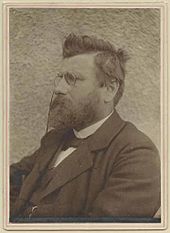Carl Hocheder

Carl Hocheder (born March 7, 1854 in Weiherhammer ; † January 21, 1917 in Munich ) was a German architect , construction clerk and university professor .
Life
Carl Hocheder was born as the son of a civil servant in Weiherhammer near Weiden in the Upper Palatinate . He studied from 1874 to 1878 Architecture at the Technical University of Munich , where he worked as a trainee after working for the railway section of Landshut , the General Directorate of Traffic institutions and the Landesbauamt Munich from 1881 to 1885 Friedrich von Thiersch assisted. After Hocheder worked as a building authority assessor in Amberg in 1885 , he worked from 1886 to 1889 as a building officer at the Munich City Building Department.
From 1898, Carl Hocheder was Albert Geul's successor as a full professor of building science at the Technical University of Munich . Alongside Theodor Fischer and Hans Grässel , he is one of the architects who significantly shaped the Munich cityscape at the turn of the century. He tried to create a school education with his own style of "Munich Baroque" (also: "Hocheder-Barock"), which he partly succeeded in doing when you look at the buildings of his students (including Hans Reissinger ).
In 1903, Hocheder received an offer as a town planning officer in Frankfurt am Main , but turned it down.
plant
Buildings (selection)
- 1889–1890: School on Bergmannstrasse in Munich
- 1890–1893: Parish church of St. Jakobus Major (the elder) in Mitterteich
- 1891: Red Cross Hospital on Nymphenburgerstrasse in Munich
- 1892–1894: St. Martin's welfare center in Munich- Giesing
- 1894: Rectory , Gietlstrasse 2 in Munich
- 1894–1895: Kirchenstrasse 9 (Munich)
- 1894–1896: School on Columbusstrasse in Munich
- 1896: Elementary school on Bazeillesstrasse in Munich Haidhausen. (Elementary school on Balanstrasse during construction.)
- 1895: Turbine house on Maximiliansbrücke in Munich
- 1895–1898: Expansion of the Muffat factory in Munich
- 1897–1899: School on Stielerstraße in Munich
- 1897–1901: Müller'sches Volksbad in Munich
- 1902–1904: Main fire station in Munich
- 1903–1904: Evangelical Lutheran Ascension Church in Pasing
- 1904–1906: Bathing establishment in Sibiu (Transylvania)
- 1905–1913: Ministry of Transport in Munich
- 1907: Town hall in Bozen
- 1907–1909: Hirschberg Castle on the Haarsee near Weilheim in Upper Bavaria
- 1907–1910: Baths in Bankja in Sofia (Bulgaria)
- 1910–1913: Neuegling Castle in Murnau-Neuegling
- Gustav von Schlör monument in Weiden in the Upper Palatinate (marble bust by the sculptor Theodor Haf )
Fonts
- Architecture and image effect. Süddeutsche Verlagsanstalt, Munich 1903 (printed version of a lecture by Hocheder at the Technical University of Munich on February 27, 1903, digitized ).
literature
- Erwin Schleich : Hocheder, Karl. In: New German Biography (NDB). Volume 9, Duncker & Humblot, Berlin 1972, ISBN 3-428-00190-7 , p. 285 f. ( Digitized version ).
- Barbara Hartmann: The Müller'sche Volksbad in Munich. (= Writings from the Institute for Art History at the University of Munich 16). Tuduv Verlag, Munich 1987.
Web links
- Carl Hocheder. In: arch INFORM .
| personal data | |
|---|---|
| SURNAME | Hocheder, Carl |
| ALTERNATIVE NAMES | Hocheder, Karl (alternative spelling) |
| BRIEF DESCRIPTION | German architect, construction officer and university professor |
| DATE OF BIRTH | March 7, 1854 |
| PLACE OF BIRTH | Weiherhammer |
| DATE OF DEATH | January 21, 1917 |
| Place of death | Munich |



